MGT502: Annotated Bibliography: Social Media's Impact on Business
VerifiedAdded on 2022/10/06
|8
|2033
|27
Annotated Bibliography
AI Summary
This annotated bibliography explores the multifaceted role of social media in modern business organizations. It analyzes ten scholarly sources, encompassing surveys, literature reviews, and case studies, to understand how social media impacts communication, collaboration, and organizational performance. The sources examine the adoption of social media tools like blogs, wikis, and instant messaging, highlighting their effectiveness in team communication and crisis management. The bibliography also investigates the affordances of social media, such as visibility and editability, and their influence on information sharing, relationship building, and employee engagement. Furthermore, the sources address the importance of internal communication, innovation culture, and the implications of social media on external communications, including customer relations and branding. The research also touches on the impact of social media on the public sector, emphasizing transparency and accountability. Finally, the bibliography highlights the importance of considering both management and employee perspectives in the implementation of social media strategies and the potential risks of information leakage. The findings suggest that social media has become an essential component of modern business operations, influencing both internal and external communications, and driving employee engagement and organizational success. The bibliography provides a comprehensive overview of the current state of research on social media in business, highlighting its benefits, challenges, and future potential.
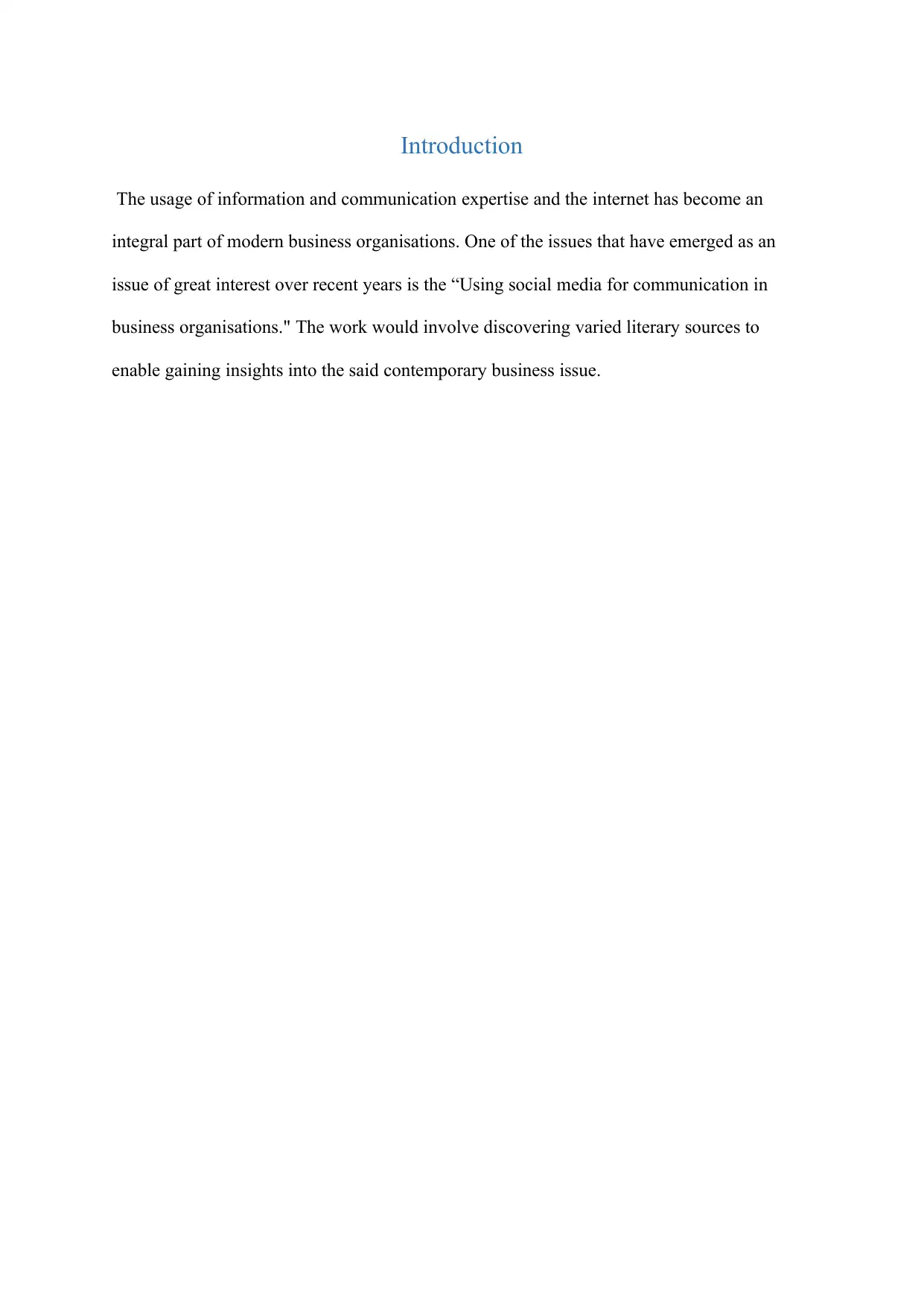
Introduction
The usage of information and communication expertise and the internet has become an
integral part of modern business organisations. One of the issues that have emerged as an
issue of great interest over recent years is the “Using social media for communication in
business organisations." The work would involve discovering varied literary sources to
enable gaining insights into the said contemporary business issue.
The usage of information and communication expertise and the internet has become an
integral part of modern business organisations. One of the issues that have emerged as an
issue of great interest over recent years is the “Using social media for communication in
business organisations." The work would involve discovering varied literary sources to
enable gaining insights into the said contemporary business issue.
Paraphrase This Document
Need a fresh take? Get an instant paraphrase of this document with our AI Paraphraser
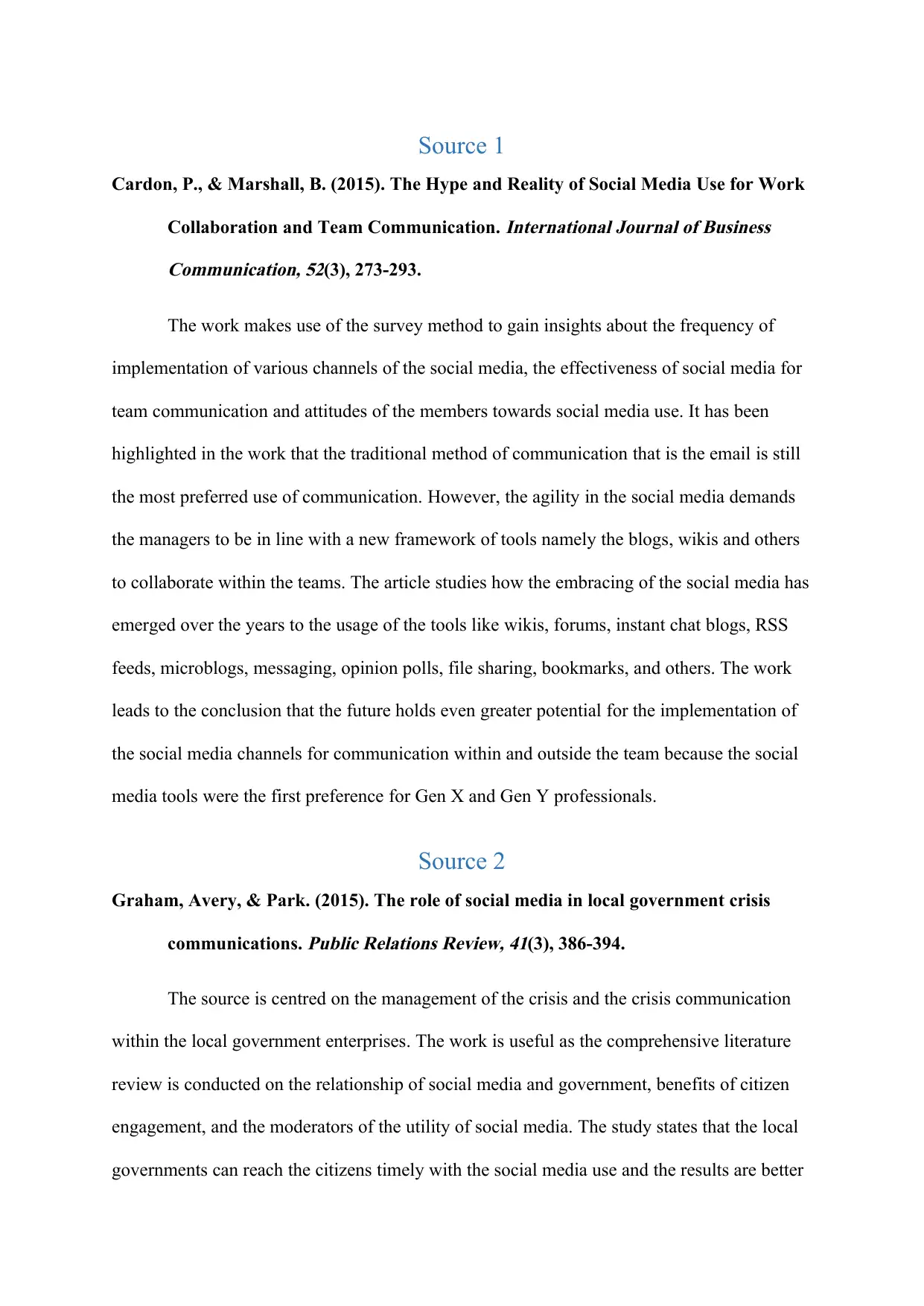
Source 1
Cardon, P., & Marshall, B. (2015). The Hype and Reality of Social Media Use for Work
Collaboration and Team Communication.
International Journal of Business
Communication, 52(3), 273-293.
The work makes use of the survey method to gain insights about the frequency of
implementation of various channels of the social media, the effectiveness of social media for
team communication and attitudes of the members towards social media use. It has been
highlighted in the work that the traditional method of communication that is the email is still
the most preferred use of communication. However, the agility in the social media demands
the managers to be in line with a new framework of tools namely the blogs, wikis and others
to collaborate within the teams. The article studies how the embracing of the social media has
emerged over the years to the usage of the tools like wikis, forums, instant chat blogs, RSS
feeds, microblogs, messaging, opinion polls, file sharing, bookmarks, and others. The work
leads to the conclusion that the future holds even greater potential for the implementation of
the social media channels for communication within and outside the team because the social
media tools were the first preference for Gen X and Gen Y professionals.
Source 2
Graham, Avery, & Park. (2015). The role of social media in local government crisis
communications.
Public Relations Review, 41(3), 386-394.
The source is centred on the management of the crisis and the crisis communication
within the local government enterprises. The work is useful as the comprehensive literature
review is conducted on the relationship of social media and government, benefits of citizen
engagement, and the moderators of the utility of social media. The study states that the local
governments can reach the citizens timely with the social media use and the results are better
Cardon, P., & Marshall, B. (2015). The Hype and Reality of Social Media Use for Work
Collaboration and Team Communication.
International Journal of Business
Communication, 52(3), 273-293.
The work makes use of the survey method to gain insights about the frequency of
implementation of various channels of the social media, the effectiveness of social media for
team communication and attitudes of the members towards social media use. It has been
highlighted in the work that the traditional method of communication that is the email is still
the most preferred use of communication. However, the agility in the social media demands
the managers to be in line with a new framework of tools namely the blogs, wikis and others
to collaborate within the teams. The article studies how the embracing of the social media has
emerged over the years to the usage of the tools like wikis, forums, instant chat blogs, RSS
feeds, microblogs, messaging, opinion polls, file sharing, bookmarks, and others. The work
leads to the conclusion that the future holds even greater potential for the implementation of
the social media channels for communication within and outside the team because the social
media tools were the first preference for Gen X and Gen Y professionals.
Source 2
Graham, Avery, & Park. (2015). The role of social media in local government crisis
communications.
Public Relations Review, 41(3), 386-394.
The source is centred on the management of the crisis and the crisis communication
within the local government enterprises. The work is useful as the comprehensive literature
review is conducted on the relationship of social media and government, benefits of citizen
engagement, and the moderators of the utility of social media. The study states that the local
governments can reach the citizens timely with the social media use and the results are better
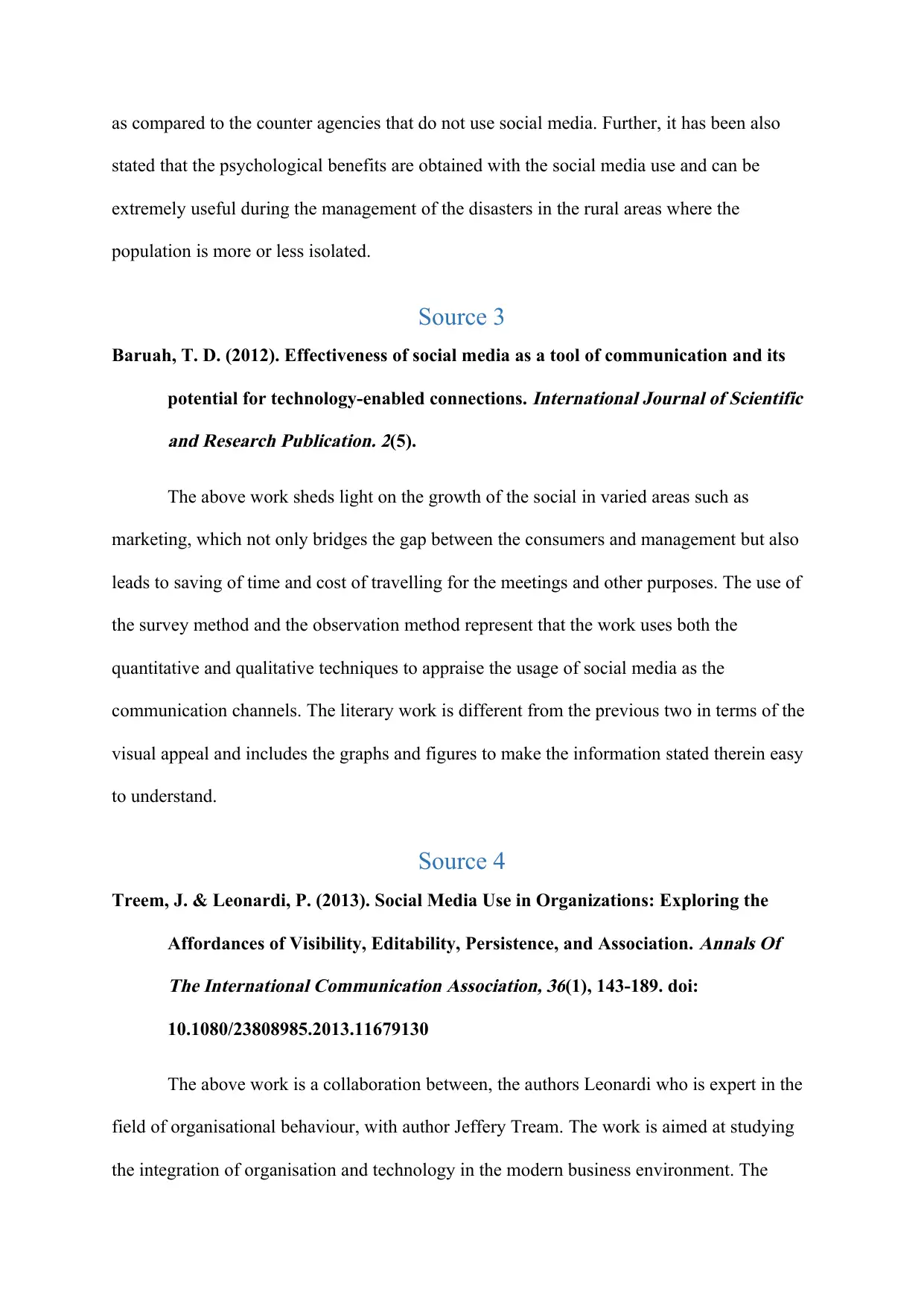
as compared to the counter agencies that do not use social media. Further, it has been also
stated that the psychological benefits are obtained with the social media use and can be
extremely useful during the management of the disasters in the rural areas where the
population is more or less isolated.
Source 3
Baruah, T. D. (2012). Effectiveness of social media as a tool of communication and its
potential for technology-enabled connections.
International Journal of Scientific
and Research Publication. 2(5).
The above work sheds light on the growth of the social in varied areas such as
marketing, which not only bridges the gap between the consumers and management but also
leads to saving of time and cost of travelling for the meetings and other purposes. The use of
the survey method and the observation method represent that the work uses both the
quantitative and qualitative techniques to appraise the usage of social media as the
communication channels. The literary work is different from the previous two in terms of the
visual appeal and includes the graphs and figures to make the information stated therein easy
to understand.
Source 4
Treem, J. & Leonardi, P. (2013). Social Media Use in Organizations: Exploring the
Affordances of Visibility, Editability, Persistence, and Association.
Annals Of
The International Communication Association, 36(1), 143-189. doi:
10.1080/23808985.2013.11679130
The above work is a collaboration between, the authors Leonardi who is expert in the
field of organisational behaviour, with author Jeffery Tream. The work is aimed at studying
the integration of organisation and technology in the modern business environment. The
stated that the psychological benefits are obtained with the social media use and can be
extremely useful during the management of the disasters in the rural areas where the
population is more or less isolated.
Source 3
Baruah, T. D. (2012). Effectiveness of social media as a tool of communication and its
potential for technology-enabled connections.
International Journal of Scientific
and Research Publication. 2(5).
The above work sheds light on the growth of the social in varied areas such as
marketing, which not only bridges the gap between the consumers and management but also
leads to saving of time and cost of travelling for the meetings and other purposes. The use of
the survey method and the observation method represent that the work uses both the
quantitative and qualitative techniques to appraise the usage of social media as the
communication channels. The literary work is different from the previous two in terms of the
visual appeal and includes the graphs and figures to make the information stated therein easy
to understand.
Source 4
Treem, J. & Leonardi, P. (2013). Social Media Use in Organizations: Exploring the
Affordances of Visibility, Editability, Persistence, and Association.
Annals Of
The International Communication Association, 36(1), 143-189. doi:
10.1080/23808985.2013.11679130
The above work is a collaboration between, the authors Leonardi who is expert in the
field of organisational behaviour, with author Jeffery Tream. The work is aimed at studying
the integration of organisation and technology in the modern business environment. The
⊘ This is a preview!⊘
Do you want full access?
Subscribe today to unlock all pages.

Trusted by 1+ million students worldwide
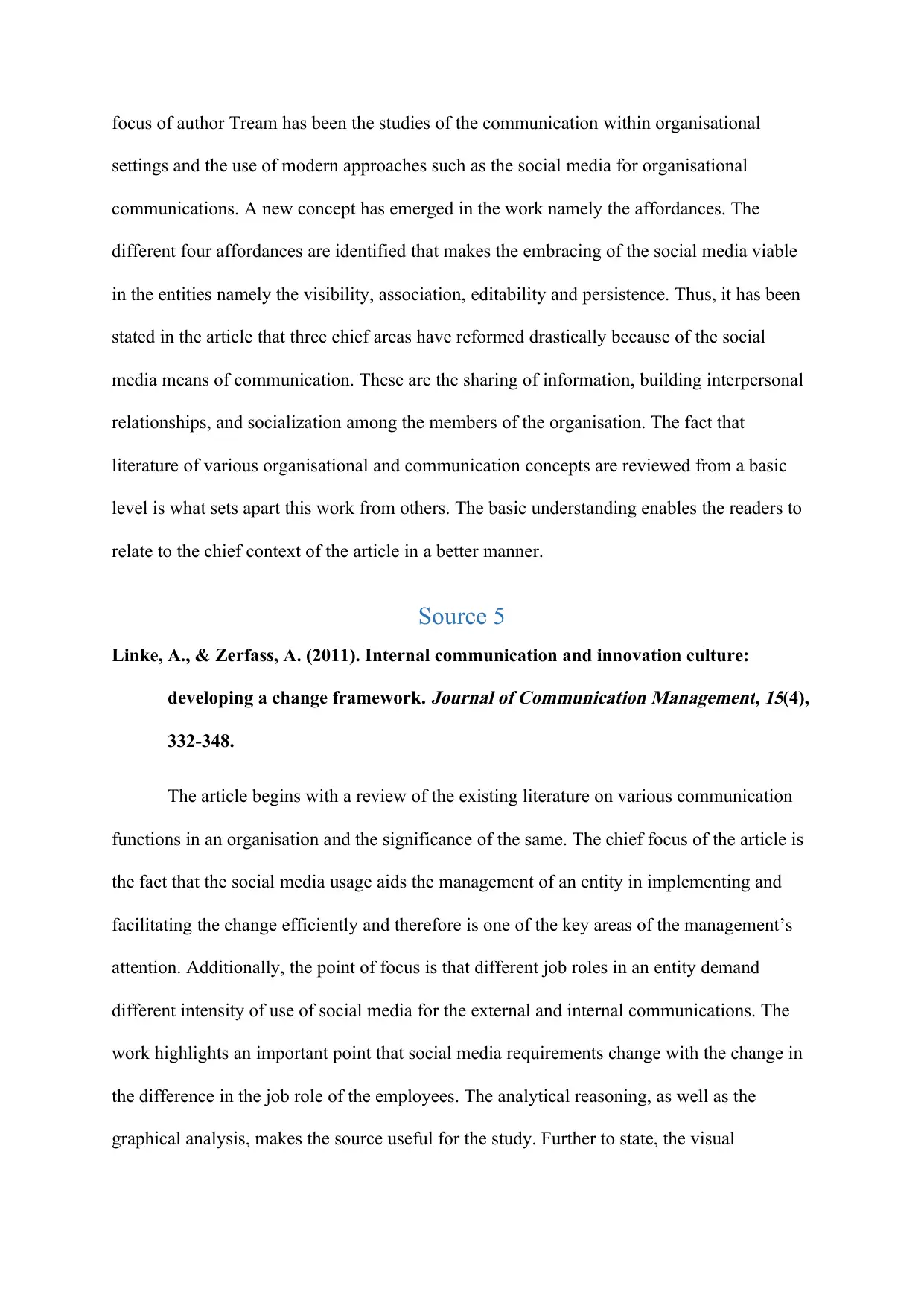
focus of author Tream has been the studies of the communication within organisational
settings and the use of modern approaches such as the social media for organisational
communications. A new concept has emerged in the work namely the affordances. The
different four affordances are identified that makes the embracing of the social media viable
in the entities namely the visibility, association, editability and persistence. Thus, it has been
stated in the article that three chief areas have reformed drastically because of the social
media means of communication. These are the sharing of information, building interpersonal
relationships, and socialization among the members of the organisation. The fact that
literature of various organisational and communication concepts are reviewed from a basic
level is what sets apart this work from others. The basic understanding enables the readers to
relate to the chief context of the article in a better manner.
Source 5
Linke, A., & Zerfass, A. (2011). Internal communication and innovation culture:
developing a change framework.
Journal of Communication Management,
15(4),
332-348.
The article begins with a review of the existing literature on various communication
functions in an organisation and the significance of the same. The chief focus of the article is
the fact that the social media usage aids the management of an entity in implementing and
facilitating the change efficiently and therefore is one of the key areas of the management’s
attention. Additionally, the point of focus is that different job roles in an entity demand
different intensity of use of social media for the external and internal communications. The
work highlights an important point that social media requirements change with the change in
the difference in the job role of the employees. The analytical reasoning, as well as the
graphical analysis, makes the source useful for the study. Further to state, the visual
settings and the use of modern approaches such as the social media for organisational
communications. A new concept has emerged in the work namely the affordances. The
different four affordances are identified that makes the embracing of the social media viable
in the entities namely the visibility, association, editability and persistence. Thus, it has been
stated in the article that three chief areas have reformed drastically because of the social
media means of communication. These are the sharing of information, building interpersonal
relationships, and socialization among the members of the organisation. The fact that
literature of various organisational and communication concepts are reviewed from a basic
level is what sets apart this work from others. The basic understanding enables the readers to
relate to the chief context of the article in a better manner.
Source 5
Linke, A., & Zerfass, A. (2011). Internal communication and innovation culture:
developing a change framework.
Journal of Communication Management,
15(4),
332-348.
The article begins with a review of the existing literature on various communication
functions in an organisation and the significance of the same. The chief focus of the article is
the fact that the social media usage aids the management of an entity in implementing and
facilitating the change efficiently and therefore is one of the key areas of the management’s
attention. Additionally, the point of focus is that different job roles in an entity demand
different intensity of use of social media for the external and internal communications. The
work highlights an important point that social media requirements change with the change in
the difference in the job role of the employees. The analytical reasoning, as well as the
graphical analysis, makes the source useful for the study. Further to state, the visual
Paraphrase This Document
Need a fresh take? Get an instant paraphrase of this document with our AI Paraphraser
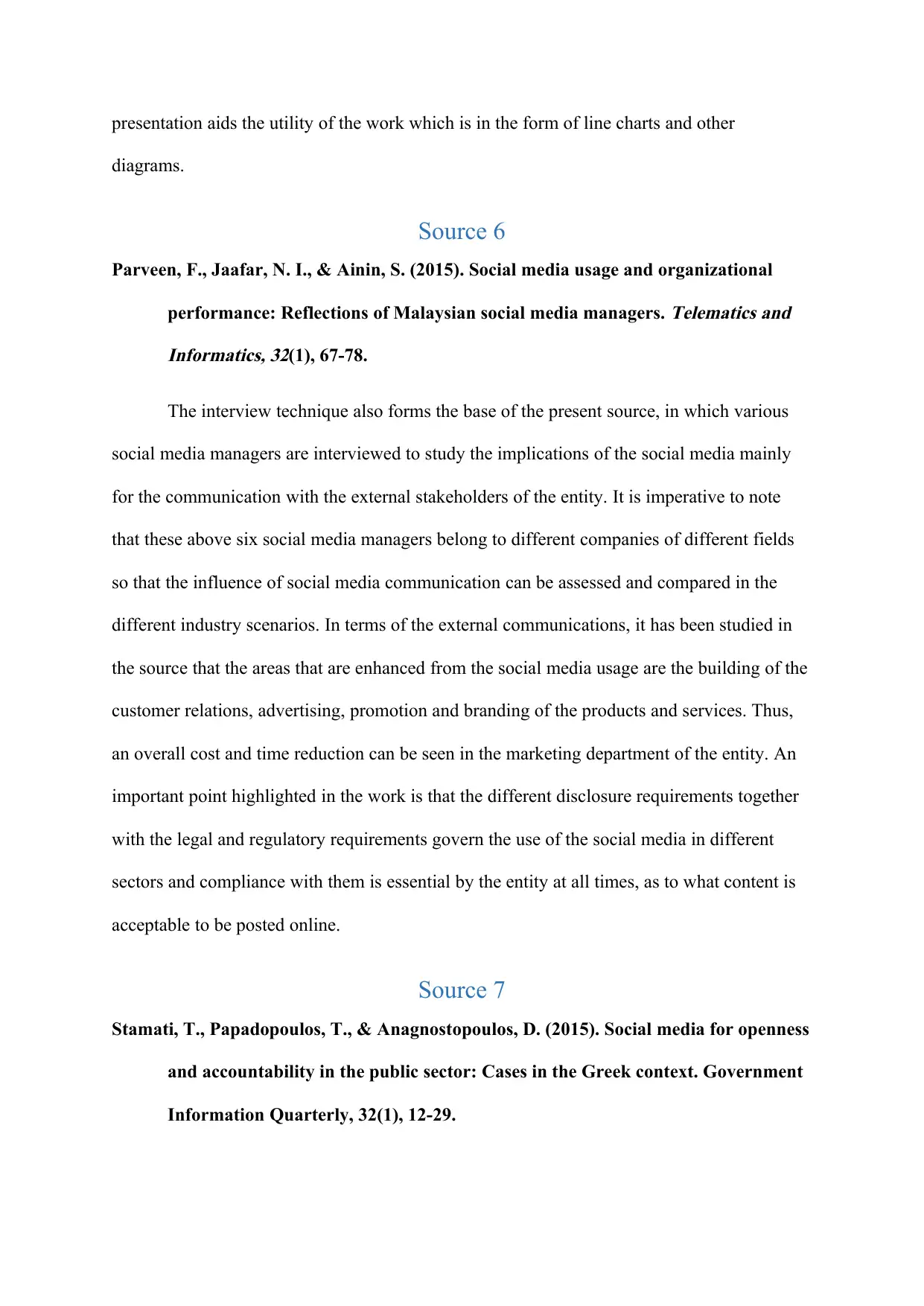
presentation aids the utility of the work which is in the form of line charts and other
diagrams.
Source 6
Parveen, F., Jaafar, N. I., & Ainin, S. (2015). Social media usage and organizational
performance: Reflections of Malaysian social media managers.
Telematics and
Informatics, 32(1), 67-78.
The interview technique also forms the base of the present source, in which various
social media managers are interviewed to study the implications of the social media mainly
for the communication with the external stakeholders of the entity. It is imperative to note
that these above six social media managers belong to different companies of different fields
so that the influence of social media communication can be assessed and compared in the
different industry scenarios. In terms of the external communications, it has been studied in
the source that the areas that are enhanced from the social media usage are the building of the
customer relations, advertising, promotion and branding of the products and services. Thus,
an overall cost and time reduction can be seen in the marketing department of the entity. An
important point highlighted in the work is that the different disclosure requirements together
with the legal and regulatory requirements govern the use of the social media in different
sectors and compliance with them is essential by the entity at all times, as to what content is
acceptable to be posted online.
Source 7
Stamati, T., Papadopoulos, T., & Anagnostopoulos, D. (2015). Social media for openness
and accountability in the public sector: Cases in the Greek context. Government
Information Quarterly, 32(1), 12-29.
diagrams.
Source 6
Parveen, F., Jaafar, N. I., & Ainin, S. (2015). Social media usage and organizational
performance: Reflections of Malaysian social media managers.
Telematics and
Informatics, 32(1), 67-78.
The interview technique also forms the base of the present source, in which various
social media managers are interviewed to study the implications of the social media mainly
for the communication with the external stakeholders of the entity. It is imperative to note
that these above six social media managers belong to different companies of different fields
so that the influence of social media communication can be assessed and compared in the
different industry scenarios. In terms of the external communications, it has been studied in
the source that the areas that are enhanced from the social media usage are the building of the
customer relations, advertising, promotion and branding of the products and services. Thus,
an overall cost and time reduction can be seen in the marketing department of the entity. An
important point highlighted in the work is that the different disclosure requirements together
with the legal and regulatory requirements govern the use of the social media in different
sectors and compliance with them is essential by the entity at all times, as to what content is
acceptable to be posted online.
Source 7
Stamati, T., Papadopoulos, T., & Anagnostopoulos, D. (2015). Social media for openness
and accountability in the public sector: Cases in the Greek context. Government
Information Quarterly, 32(1), 12-29.
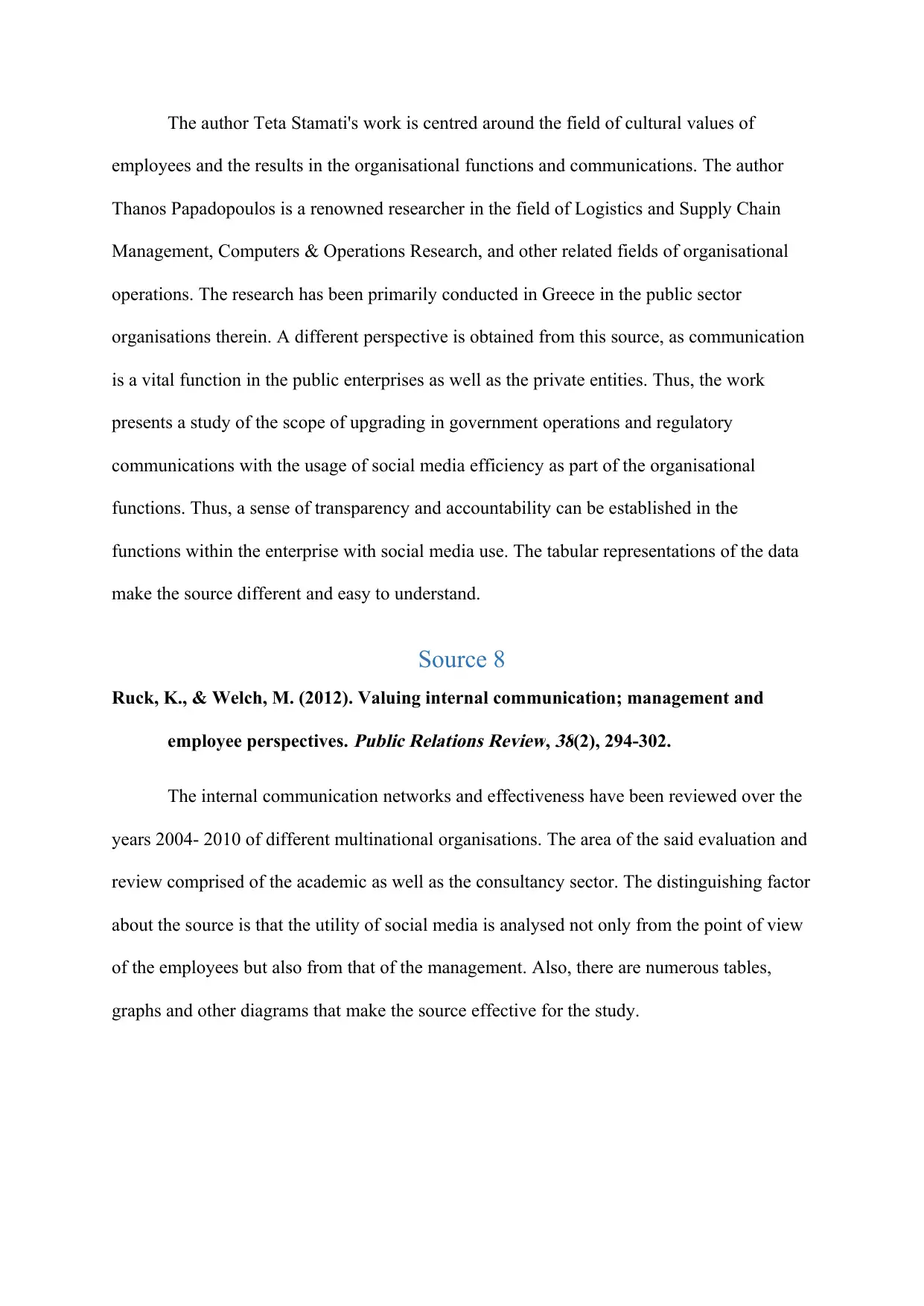
The author Teta Stamati's work is centred around the field of cultural values of
employees and the results in the organisational functions and communications. The author
Thanos Papadopoulos is a renowned researcher in the field of Logistics and Supply Chain
Management, Computers & Operations Research, and other related fields of organisational
operations. The research has been primarily conducted in Greece in the public sector
organisations therein. A different perspective is obtained from this source, as communication
is a vital function in the public enterprises as well as the private entities. Thus, the work
presents a study of the scope of upgrading in government operations and regulatory
communications with the usage of social media efficiency as part of the organisational
functions. Thus, a sense of transparency and accountability can be established in the
functions within the enterprise with social media use. The tabular representations of the data
make the source different and easy to understand.
Source 8
Ruck, K., & Welch, M. (2012). Valuing internal communication; management and
employee perspectives.
Public Relations Review,
38(2), 294-302.
The internal communication networks and effectiveness have been reviewed over the
years 2004- 2010 of different multinational organisations. The area of the said evaluation and
review comprised of the academic as well as the consultancy sector. The distinguishing factor
about the source is that the utility of social media is analysed not only from the point of view
of the employees but also from that of the management. Also, there are numerous tables,
graphs and other diagrams that make the source effective for the study.
employees and the results in the organisational functions and communications. The author
Thanos Papadopoulos is a renowned researcher in the field of Logistics and Supply Chain
Management, Computers & Operations Research, and other related fields of organisational
operations. The research has been primarily conducted in Greece in the public sector
organisations therein. A different perspective is obtained from this source, as communication
is a vital function in the public enterprises as well as the private entities. Thus, the work
presents a study of the scope of upgrading in government operations and regulatory
communications with the usage of social media efficiency as part of the organisational
functions. Thus, a sense of transparency and accountability can be established in the
functions within the enterprise with social media use. The tabular representations of the data
make the source different and easy to understand.
Source 8
Ruck, K., & Welch, M. (2012). Valuing internal communication; management and
employee perspectives.
Public Relations Review,
38(2), 294-302.
The internal communication networks and effectiveness have been reviewed over the
years 2004- 2010 of different multinational organisations. The area of the said evaluation and
review comprised of the academic as well as the consultancy sector. The distinguishing factor
about the source is that the utility of social media is analysed not only from the point of view
of the employees but also from that of the management. Also, there are numerous tables,
graphs and other diagrams that make the source effective for the study.
⊘ This is a preview!⊘
Do you want full access?
Subscribe today to unlock all pages.

Trusted by 1+ million students worldwide
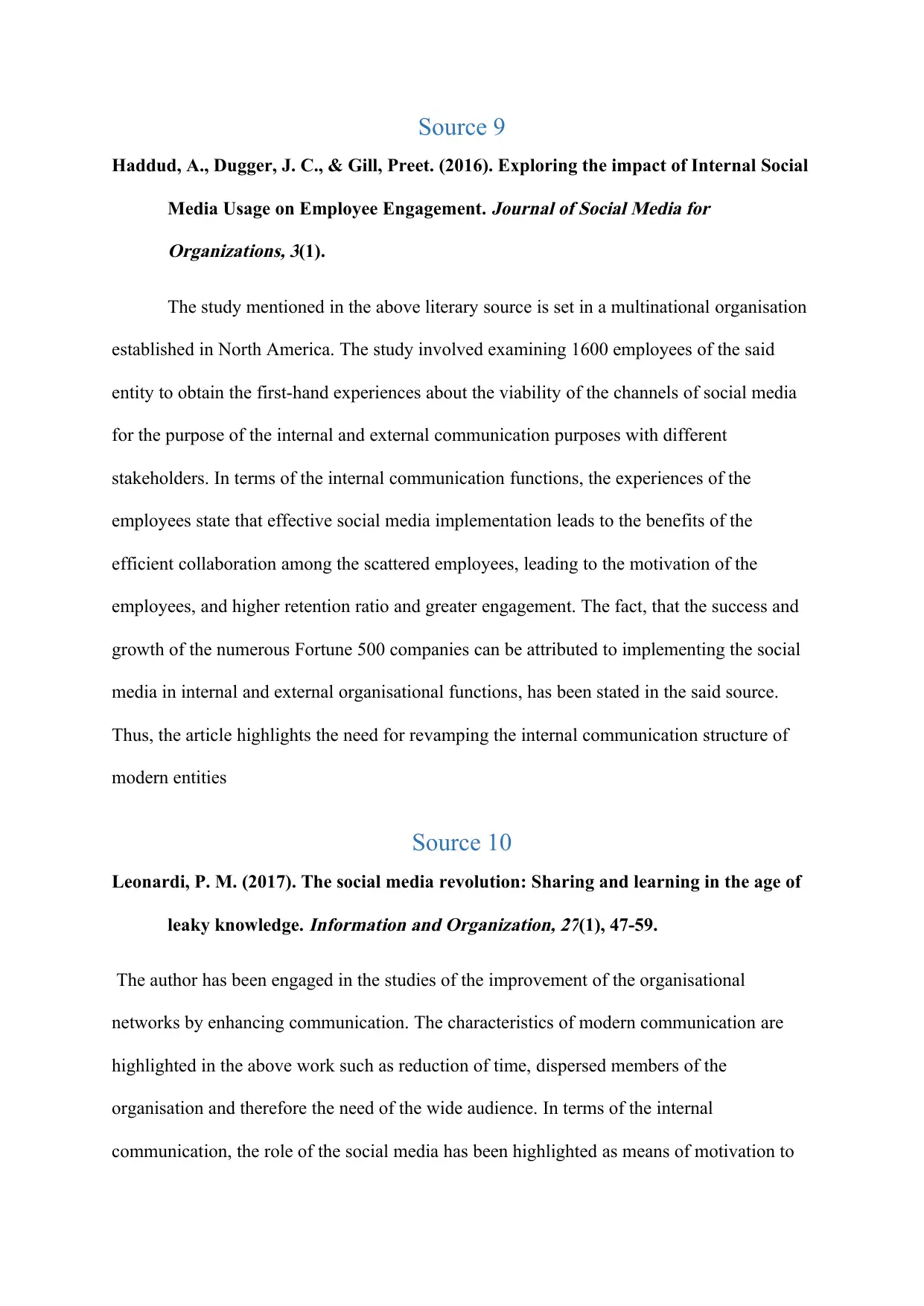
Source 9
Haddud, A., Dugger, J. C., & Gill, Preet. (2016). Exploring the impact of Internal Social
Media Usage on Employee Engagement.
Journal of Social Media for
Organizations, 3(1).
The study mentioned in the above literary source is set in a multinational organisation
established in North America. The study involved examining 1600 employees of the said
entity to obtain the first-hand experiences about the viability of the channels of social media
for the purpose of the internal and external communication purposes with different
stakeholders. In terms of the internal communication functions, the experiences of the
employees state that effective social media implementation leads to the benefits of the
efficient collaboration among the scattered employees, leading to the motivation of the
employees, and higher retention ratio and greater engagement. The fact, that the success and
growth of the numerous Fortune 500 companies can be attributed to implementing the social
media in internal and external organisational functions, has been stated in the said source.
Thus, the article highlights the need for revamping the internal communication structure of
modern entities
Source 10
Leonardi, P. M. (2017). The social media revolution: Sharing and learning in the age of
leaky knowledge.
Information and Organization, 27(1), 47-59.
The author has been engaged in the studies of the improvement of the organisational
networks by enhancing communication. The characteristics of modern communication are
highlighted in the above work such as reduction of time, dispersed members of the
organisation and therefore the need of the wide audience. In terms of the internal
communication, the role of the social media has been highlighted as means of motivation to
Haddud, A., Dugger, J. C., & Gill, Preet. (2016). Exploring the impact of Internal Social
Media Usage on Employee Engagement.
Journal of Social Media for
Organizations, 3(1).
The study mentioned in the above literary source is set in a multinational organisation
established in North America. The study involved examining 1600 employees of the said
entity to obtain the first-hand experiences about the viability of the channels of social media
for the purpose of the internal and external communication purposes with different
stakeholders. In terms of the internal communication functions, the experiences of the
employees state that effective social media implementation leads to the benefits of the
efficient collaboration among the scattered employees, leading to the motivation of the
employees, and higher retention ratio and greater engagement. The fact, that the success and
growth of the numerous Fortune 500 companies can be attributed to implementing the social
media in internal and external organisational functions, has been stated in the said source.
Thus, the article highlights the need for revamping the internal communication structure of
modern entities
Source 10
Leonardi, P. M. (2017). The social media revolution: Sharing and learning in the age of
leaky knowledge.
Information and Organization, 27(1), 47-59.
The author has been engaged in the studies of the improvement of the organisational
networks by enhancing communication. The characteristics of modern communication are
highlighted in the above work such as reduction of time, dispersed members of the
organisation and therefore the need of the wide audience. In terms of the internal
communication, the role of the social media has been highlighted as means of motivation to
Paraphrase This Document
Need a fresh take? Get an instant paraphrase of this document with our AI Paraphraser
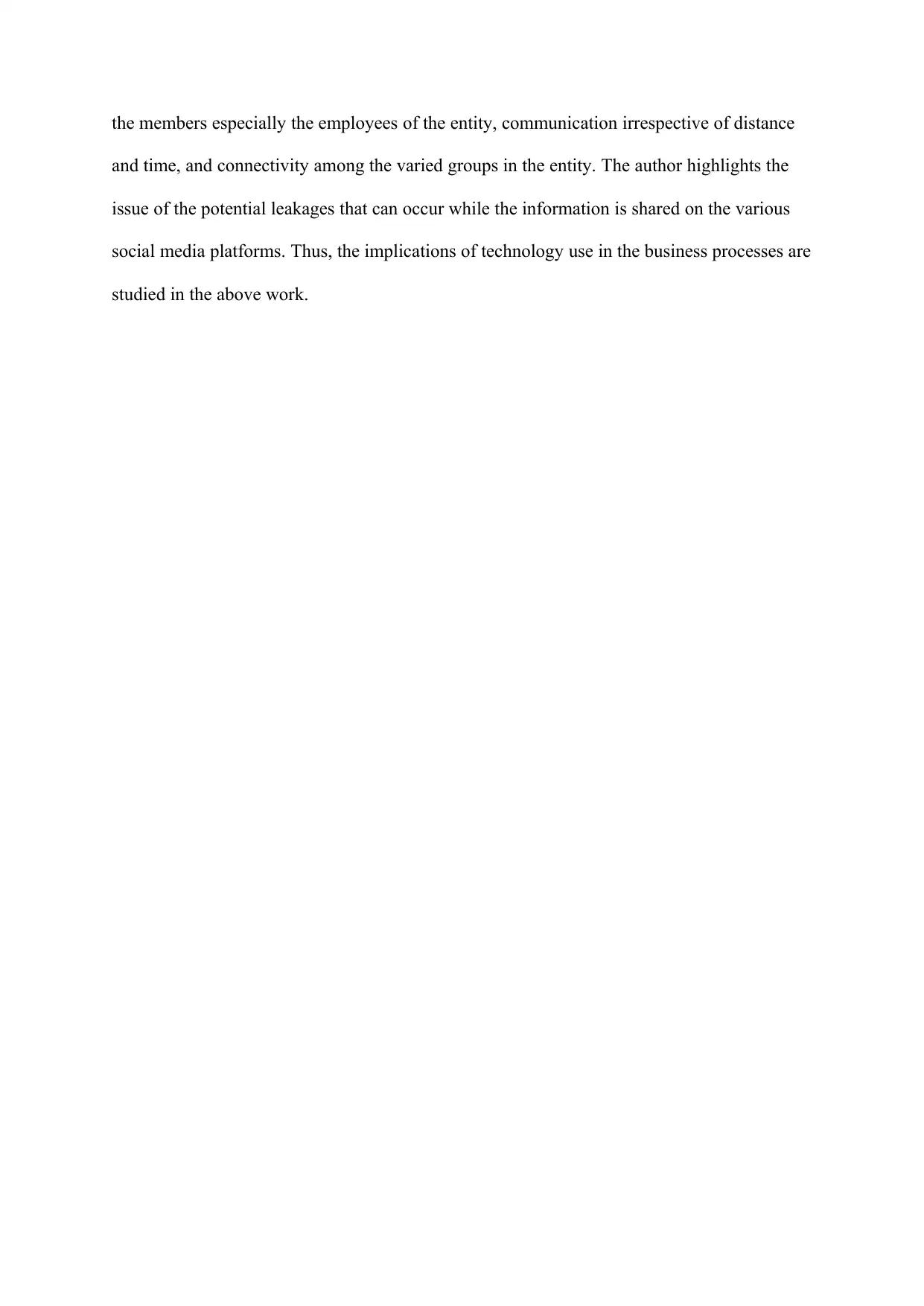
the members especially the employees of the entity, communication irrespective of distance
and time, and connectivity among the varied groups in the entity. The author highlights the
issue of the potential leakages that can occur while the information is shared on the various
social media platforms. Thus, the implications of technology use in the business processes are
studied in the above work.
and time, and connectivity among the varied groups in the entity. The author highlights the
issue of the potential leakages that can occur while the information is shared on the various
social media platforms. Thus, the implications of technology use in the business processes are
studied in the above work.
1 out of 8
Related Documents
Your All-in-One AI-Powered Toolkit for Academic Success.
+13062052269
info@desklib.com
Available 24*7 on WhatsApp / Email
![[object Object]](/_next/static/media/star-bottom.7253800d.svg)
Unlock your academic potential
Copyright © 2020–2025 A2Z Services. All Rights Reserved. Developed and managed by ZUCOL.





